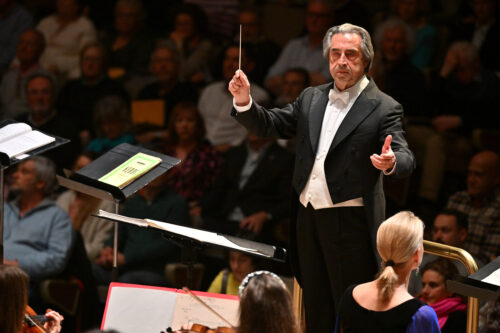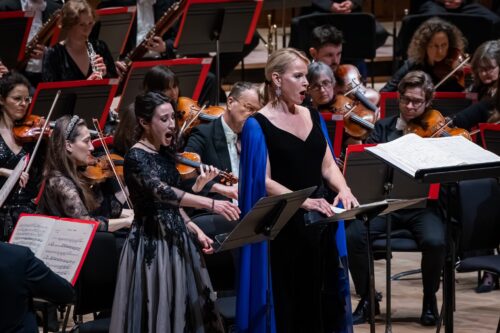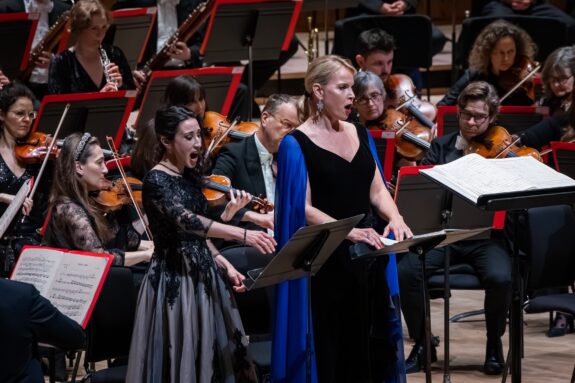 United Kingdom Verdi, Requiem: Marie Lys (soprano), Elīna Garanča (mezzo-soprano), Piotr Beczała (tenor), William Thomas (bass), Philharmonia Chorus (chorus master: Gavin Carr) and Orchestra / Riccardo Muti (conductor). Royal Festival Hall, London, 27.3.2025. (JR)
United Kingdom Verdi, Requiem: Marie Lys (soprano), Elīna Garanča (mezzo-soprano), Piotr Beczała (tenor), William Thomas (bass), Philharmonia Chorus (chorus master: Gavin Carr) and Orchestra / Riccardo Muti (conductor). Royal Festival Hall, London, 27.3.2025. (JR)

Verdi – Requiem
It was as long ago as 2010 when Muti last visited Britain to conduct the Philharmonia. This concert of Verdi’s Messa da Requiem was to have been in 2020, but COVID-19 struck.
Neil Fisher, chief music critic of The Times recently interviewed Riccardo Muti and aptly described him as the last of the ‘Big Beasts’. Tickets for this concert were like gold-dust, the hall was packed to the gunwales; there were people standing (with paid tickets) at the rear of the stalls. This was not simply another concert – it was a major musical event. There were former players of the Philharmonia Orchestra in the audience who had performed under Muti when he was their Principal Conductor from 1972 to 1982 (I vividly recall his white-hot Tchaikovsky symphony performances with the orchestra at the end of the Seventies); there was the Far East contingent who only seem to emerge for the Big Names; and music-lovers had travelled from far and wide to witness the occasion. Muti has been performing and recording this work for decades, knows every note, and has developed his own quite distinct and powerful interpretation, even if not adhering strictly to the composer’s markings. Some passages are slower than you would expect, others faster such as the start of the ‘Sanctus’ which almost caught the chorus off-guard.
Muti also has his favoured group of soloists for this week, so was unfortunate that both his soprano withdrew some weeks ago – and his Italian bass pulled out before they could stop printing the concert programmes with his name.

Of the four soloists, two were simply in a different league. Latvian mezzo-soprano Elīna Garanča was radiant, spellbinding and commanding in ‘Liber scriptus’. Polish tenor Piotr Beczała was on his very best unsurpassable form: his ‘Ingemisco’ was a delight, saving his voice a touch for a thrilling ‘statuens in parte dextra’ finish. Beczała stole the show again in his delivery of ‘Hostias et preces’. Though Swiss soprano Marie Lys had glitter in her top notes, she lacked the volume needed for much of the part, especially in the final section, the ‘Libera me’. Young British bass William Thomas stepped in bravely at the very last minute into the distinguished line of soloists and, whilst not commanding attention, certainly did not let anyone down. He seemed (understandably?) slightly in awe of the grand occasion. Muti kept a close eye and ear on him to ensure his tempi were being followed. Thomas does not, in my view, quite have the right dark stentorian Italianate voice for this role: Thomas was happier with the lighter, baritone tones.
The chorus were first class, from the hushed unaccompanied opening ‘Requiem aeternam’ to the hurled out ‘Dies irae’. Muti had clearly been working on them to clearly pronounce certain important words such as ‘calamitatis’. I admired, in particular, the intonation of the sopranos on their high notes and the mellow weight of the alto section. The men came strongly to the fore in an overwhelming ‘Tuba mirum’ and shook away the cobwebs with a forceful ‘Rex tremendae’, though having them stand right on their first note did not make their job easy.
The orchestra also did not put a foot wrong. I highlight the impressive cello section’s introduction to the ‘Offertorio’. The orchestra (including offstage trumpets) was often at full cry, following Muti’s minute changes in tempi and meticulous phrasing to the letter. It was interesting (for lovers of old instruments) to spot a cimbasso in the brass section with its huge bell facing forwards. (In modern performances a cimbasso often replaces the predecessor of the tuba, the ophicleide – the cimbasso blends in better with the trombones rather than hearing the tuba’s distinctive voice).
That leaves me to comment on the conductor. Well, what can one say? The soloists emerged onto the stage at the start of the performance to receive their applause, and Muti appeared some – almost indecent – while later, to receive his rapturous welcome applause. At one point, a cougher in the stalls threatened to spoil the effect of a quiet section: Muti instantly turned towards him and growled visibly, to the great amusement of some in my row – the old authoritarian conductors are not quite finished yet. A large crowd of music-lovers gathered at the Artists’ Door in the hope of collecting an autograph.
It was not only a huge pleasure to attend this concert, but it was also a privilege and certainly one for the record books.
John Rhodes

It’s not conductors who ‘work’ on choruses – it’s the chorus masters. The Philharmonia Chorus has been pronouncing ‘calamitatis’ and every other part of the Requiem liturgy extremely well ever since their first chorus master, Wilhelm Pitz, started training them in 1956.
Pure as a listener I’m delighted to be reminded of Wilhelm Pitz.
Any possibility of this concert’s being released on CD I wonder?
Jim for S&H: There is no news that I know that this particular concert was recorded though Muti has recordings of other Verdi Requiems with the Philharmonia.
Speaking as a member of the chorus who performed in this concert, I can say that Muti’s Verdi Requiem is unlike any other I have encountered, and I have sung it many times. Quite apart from the variations in tempi, Muti is extremely scrupulous about how various words are emphasised. For example, the ‘di’ in Dies Irae is given more emphasis. The intention is to actually give meaning to the text, rather than just to sing the notes. Together with the electricity of the conducting, all this brings the piece to life and gives it meaning, whether or not you are a believer. A magical evening.
Who were the original soprano and bass?
Jim for S&H: Juliana Grigoryan and Ildebrando d’Arcangelo